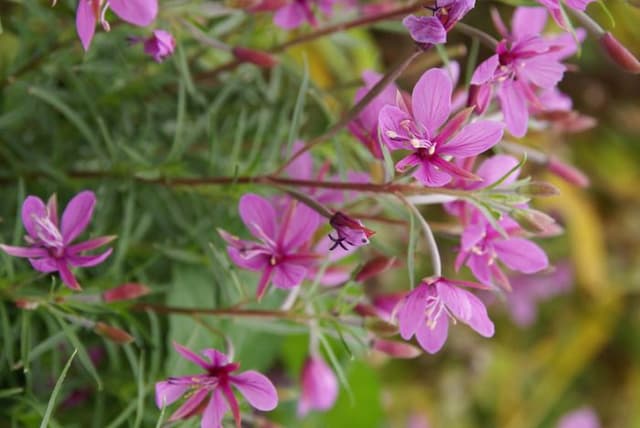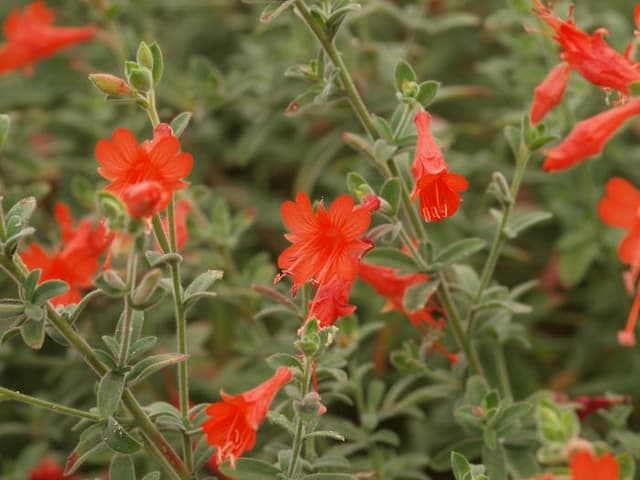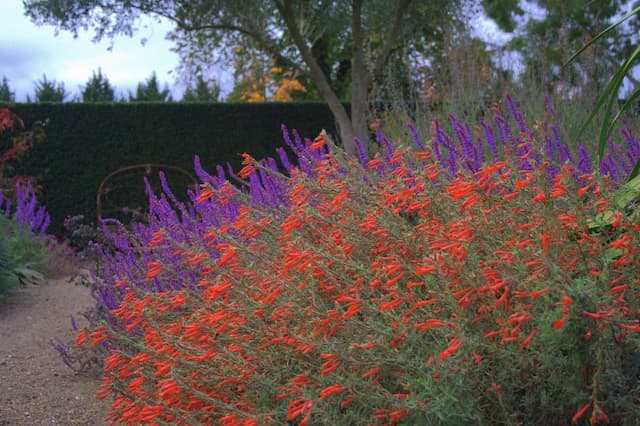California Fuchsia Epilobium canum 'Dublin' (Z)

ABOUT
Epilobium canum 'Dublin,' commonly known as California fuchsia, is a perennial plant characterized by vibrant floral displays and dense foliage. It is adorned with narrow leaves that have a slightly fuzzy texture. The leaves are typically green to gray-green. The most striking feature of California fuchsia is its flowers. They exhibit a bright, fiery hue ranging from red to orange. The flowers are tubular with flared ends and they typically bloom profusely, creating a showy display that is very attractive to hummingbirds and other pollinators. Despite the omission of specifics regarding its size, the general form of California fuchsia is that of a spreading plant that can create a full, bushy appearance. Its growth habit makes it effective as a groundcover or in borders where its bright flowers can provide a splash of color for an extended period.
About this plant
 Names
NamesSynonyms
California Fuchsia, Hummingbird Flower, Zauschneria.
Common names
Zauschneria californica, Zauschneria cana, Zauschneria canum.
 Toxicity
ToxicityTo humans
California fuchsia, known botanically as Epilobium canum 'Dublin', is not typically considered toxic to humans. There are no well-documented cases of poisoning from ingestion of this plant, and it does not contain any known toxic compounds that would pose a risk to human health when handled or ingested in normal quantities.
To pets
California fuchsia is also generally recognized as non-toxic to pets. It does not have a reputation for causing poisoning in animals such as dogs and cats, and there are no common symptoms associated with its ingestion. Therefore, pets that consume California fuchsia are not expected to experience adverse health effects due to toxicity.
 Characteristics
CharacteristicsLife cycle
Perennials
Foliage type
Evergreen
Color of leaves
Green
Flower color
Red
Height
2-3 feet (0.6-0.9 meters)
Spread
2-3 feet (0.6-0.9 meters)
Plant type
Shrub
Hardiness zones
8
Native area
California
Benefits
 General Benefits
General Benefits- Attracts Pollinators: Epilobium canum 'Dublin', commonly known as California Fuchsia, is highly attractive to hummingbirds, bees, and butterflies, which play an essential role in pollination.
- Drought Tolerance: Adapted to dry conditions, California Fuchsia requires minimal watering once established, making it an excellent choice for water-conserving gardens.
- Low Maintenance: This plant is known for being easy to care for, requiring little pruning or other maintenance tasks, making it suitable for gardeners of all skill levels.
- Vibrant Flowers: California Fuchsia produces bright reddish-orange flowers that can add a vivid splash of color to garden landscapes, particularly in late summer and fall.
- Suitable for Fire-Prone Areas: As a native of fire-prone regions, California Fuchsia is more resistant to fire than many other plants, making it an appropriate choice for fire-scaping.
- Erosion Control: The plant's spreading habit and robust root system can help stabilize soil and prevent erosion on slopes or banks.
- Deer Resistant: California Fuchsia is generally not favored by deer, which makes it a good option for gardens in areas with high deer populations.
- Adaptable to Various Soils: It can grow in a range of soil types, from sandy to loamy, provided they are well-draining.
- Long Blooming Period: The plant has a long blooming season, providing color and interest in the garden for an extended period.
 Medical Properties
Medical Properties- This plant is not used for medical purposes.
 Air-purifying Qualities
Air-purifying QualitiesThis plant is not specifically known for air purifying qualities.
 Other Uses
Other Uses- Artistic Inspiration: California fuchsia can be used by artists as a vibrant, natural subject for paintings, drawings, and photography due to its striking red-orange flowers.
- Educational Tool: This plant can be incorporated into educational programs about native Californian flora and xeriscaping practices to conserve water.
- Wine Coloration: The petals of California fuchsia could theoretically be used to naturally tint or infuse color into homemade wines or vinegars, although this use is quite atypical and care should be taken for safety and palatability.
- Craft Material: Dried flowers and stems can be used in crafting, such as making bookmarks, pressed flower art, or in potpourri mixes.
- Dye Source: The petals may yield natural dyes for textiles or art projects, giving fabrics a unique and subtle color.
- Insect Repellant: Some gardeners believe that certain compounds in the scent of California fuchsia may help repel pests, although this use is anecdotal and not scientifically substantiated.
- Festive Decor: Its flowers can be used for decorations during fall festivities due to their bright and seasonal color.
- Culinary Garnish: While not a common use, the petals could potentially be used as an edible garnish for salads and desserts, adding a splash of color, provided they've not been treated with pesticides and are cleaned properly.
- Botanical Studies: California fuchsia can be used as a subject for botanical studies and plant morphology due to its distinct adaptive traits for dry environments.
- Floral Theme Events: Live plants or cut flowers can be incorporated into event decor for events with a wildflower or natural Californian theme.
Interesting Facts
 Feng Shui
Feng ShuiThe California Fuchsia is not used in Feng Shui practice.
 Zodiac Sign Compitability
Zodiac Sign CompitabilityThe California Fuchsia is not used in astrology practice.
 Plant Symbolism
Plant Symbolism- Renewal: The Epilobium canum, commonly known as California Fuchsia, often symbolizes renewal because it blooms vigorously after a period of dormancy, much like nature's way of starting anew.
- Survival: Given its hardy nature and ability to thrive in tough conditions, California Fuchsia represents the spirit of survival and the ability to overcome challenges.
- Adaptation: As a plant that adapts well to various environments, it signifies the capacity to adjust and thrive in different circumstances.
 Water
WaterThe California Fuchsia should be watered deeply once a week during hot, dry periods, allowing the soil to dry out between waterings to encourage deep root growth. During cooler or rainy seasons, reduce watering frequency to once every two to three weeks. A general guide is to provide about 1 gallon of water per plant per watering session, depending on the size and maturity of the plant, as well as the soil conditions. It is important to avoid overwatering, which can lead to root rot and other issues. Always check the top inch of soil for dryness before watering.
 Light
LightCalifornia Fuchsia thrives in full sun conditions, receiving at least 6 to 8 hours of direct sunlight daily. The best spot for this plant is in a garden bed or location that gets unfiltered sunlight throughout the day. It can tolerate some light shade, particularly in very hot climates, but flowering may be reduced in less than full sun.
 Temperature
TemperatureCalifornia Fuchsia does well in a wide range of temperatures but is best suited to climates where temperatures stay between 60°F and 85°F. It can survive minimum temperatures down to 20°F. It's an adaptable plant and can handle the heat well, but ideal growth occurs within the warmer end of the range.
 Pruning
PruningCalifornia Fuchsia should be pruned to maintain shape and encourage bushier growth. Pruning is best done in the late winter or early spring before new growth begins. Remove any dead or damaged stems and cut back about one-third of the plant to stimulate new growth and fuller plants. Pruning once a year is typically sufficient.
 Cleaning
CleaningAs needed
 Soil
SoilCalifornia Fuchsia, commonly known as Epilobium canum 'Dublin', thrives in well-draining soil with a mix of sand, loam, and organic compost. The ideal pH for this plant ranges from slightly acidic to slightly alkaline, around 6.0 to 8.0. A balanced soil mixture aids in providing the necessary nutrients and proper root aeration.
 Repotting
RepottingCalifornia Fuchsia should be repotted every 2 to 3 years to refresh the soil and accommodate root growth. It's best to repot in the spring before the onset of the growth season to minimize stress on the plant.
 Humidity & Misting
Humidity & MistingCalifornia Fuchsia prefers moderate to low humidity levels, reflecting its native habitat. Ideal conditions do not require high humidity; average room humidity is typically sufficient for this plant's growth.
 Suitable locations
Suitable locationsIndoor
Place in bright light, water sparingly.
Outdoor
Full sun, well-drained soil, low water.
Hardiness zone
7-10 USDA
 Life cycle
Life cycleEpilobium canum 'Dublin', commonly known as the California Fuchsia 'Dublin', starts its life cycle as seeds that germinate in spring when conditions are moist and warm. The seedlings grow rapidly, developing into young plants that form a bushy structure of lance-shaped leaves. Throughout the summer, it enters a vigorous vegetative growth stage, establishing a robust root system and abundant foliage. By late summer to fall, the California Fuchsia 'Dublin' reaches its flowering stage, producing vibrant, trumpet-shaped red or orange flowers that attract hummingbirds and other pollinators. After pollination, the flowers set seed, which are then dispersed by wind, water, or wildlife, or remain in place to self-sow. In winter, the above-ground parts of the plant may die back, especially in colder climates, but the roots can survive to resprout in the following spring, completing the lifecycle.
 Propogation
PropogationPropogation time
Spring-Early Summer
The California Fuchsia, known botanically as Epilobium canum 'Dublin', is commonly propagated through softwood cuttings. The ideal time for taking cuttings is in late spring or early summer when new growth is abundant and the plant is actively growing. To propagate, a gardener would cut a 4 to 6 inch length of stem, making sure at least a couple of leaves are on the cutting. The bottom end of the cutting should be stripped of leaves and dipped in rooting hormone to encourage root development. The prepared cutting is then placed in a well-draining soil mix, ensuring the leaf nodes are buried as these are the points where roots are likely to form. The soil should be kept moist but not waterlogged, and the cuttings should be placed in a bright area but out of direct sunlight to avoid scorching. With proper care, roots will typically develop in a few weeks, after which the young plants can be gradually acclimated to outdoor conditions and ultimately transplanted to their final location in the garden.









